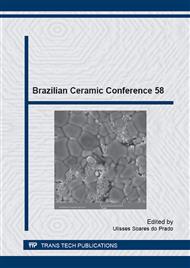p.46
p.51
p.56
p.60
p.65
p.73
p.79
p.84
p.90
Bentonite Clays Characterization in the Town of Sossego – Paraiba State
Abstract:
Bentonite exhibt a range of industrial applications moving millions of dollars on the market per year. Among several applications if highlights it is use for petroleum drilling fluids. Thus, this work aims to characterize physical, mineralogical and technologically, the bentonitics clays of Sossego County, Paraíba, Brazil. Mineralogical characterization of clays was done through the following techniques: particle size analysis by laser diffraction, thermogravimetric and differential thermal analysis, chemical analysis and x-ray diffraction. The clays were turned in by treatment with sodium in Na2CO3 and then determined whether the apparent viscosity, plastic and volume of filtrate of clay-water dispersions. The results showed that the samples are of polycationic, showing levels of MgO, CaO and K2O, similar to those from Boa Vista County, Paraíba, Brazil, and consist of clay mineral kaolinite, quartz and esmec. The clays showed rheological properties that indicate potential for use in drilling fluids.
Info:
Periodical:
Pages:
65-70
Citation:
Online since:
June 2015
Authors:
Keywords:
Price:
Сopyright:
© 2015 Trans Tech Publications Ltd. All Rights Reserved
Share:
Citation:


